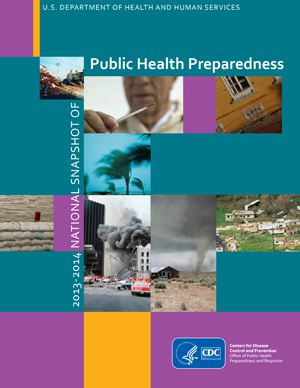CDC support to states, locals bolsters national health security
Press Release
For Immediate Release: Wednesday, January 29, 2014
Contact: Media Relations
(404) 639-3286

2013-2014 National Snapshot of Public Health Preparedness. Full Report: http://www.cdc.gov/phpr/pubs-links/2013/
Between 2012-2013, the Centers for Disease Control and Prevention supported multiple state and local public health responses, helping to strengthen the front lines of public health defense and bolster the nation’s health security. Examples of these responses, as well as an assessment of state and select local preparedness, are included in 2013-2014 National Snapshot of Public Health Preparedness, the sixth annual report from CDC’s Office of Public Health Preparedness and Response released today.
The report covers activities occurring during 2012 and 2013 and focuses on how federal investments enhance the nation’s ability to respond to public health threats, both domestically and internationally. The report includes fact sheets about the 50 states, four large metropolitan areas (New York City, Chicago, Washington, D.C., and Los Angeles County), and eight U.S. territories funded by CDC’s Public Health Emergency Preparedness (PHEP) cooperative agreement. Each awardee is assessed on their public health laboratory testing capabilities, emergency operations coordination, and emergency public information and warning systems. The report also includes summaries about the responses to Hurricane Sandy, the West Nile Virus outbreak in Texas, the tornado in Joplin, Mo., and the Super Bowl preparation in New Orleans.
“CDC support for state emergency preparedness is vital to the health security of Americans,” said CDC Director Tom Frieden, M.D., M.P.H. “The lives protected by the public health response to Hurricane Sandy, the fungal meningitis outbreak, and the tornadoes in Joplin are just a few examples of how communities and CDC can work together to protect the public’s health when its needed most.”
Highlights from the report
- In 2012, across the 62 PHEP awardees, Emergence Management Program (EMP) activities included 185 engagements and 204 exercises. Internationally, EMP activities across 35 countries included 15 activations, 19 engagements, and 12 exercises.
- During outbreaks and emergencies, response time is essential. In 2012, lead state responders reported for immediate duty within 27 minutes of receiving notification of a potential public health emergency – 9 minutes faster than the 2011 national average.
- In 2012, CDC updated its select agent regulations, resulting in reclassification and reduction of agents and toxins on the Select Agent list and established standards for individuals with access to select agents and toxins and improved physical and information security standards.
- In regulating select agents and toxins during 2012, PHPR monitored 309 facilities registered to own these agents and tracked more than 11,300 individuals with access. PHPR inspected 239 these facilities to ensure that they comply with regulations and laboratory safety and security measures.
- During 2012, of the labs that make up CDC’s Laboratory Resource Network (LRN)
- 92 percent of the LRN – biological labs passed proficiency tests for identifying biological agents in unknown samples.
- 96 percent of the LRN – chemical labs correctly identified and quantified chemical agents from unknown samples during unannounced proficiency testing.
- The percentage of E. coli-positive tests analyzed and entered into the PulseNet database within four working days increased from 90 percent to 94 percent and timely testing and reporting of Listeria-positive results increased from 88 percent to 92 percent.
- States, localities, and territorial areas ensure medicine, vaccines, and medical supplies are available to the public during large scale public health emergencies by supplementing local supplies with assets from CDC’s Strategic National Stockpile (SNS). Technical Assistance Review (TAR) scores demonstrate planning to receive, distribute, and dispense SNS assets to the public during an emergency. During 2011-2012:
- the median state TAR score was 98 (out of 100)
- the median locality TAR score was 100 (out of 100)
“The ability of our local and state health departments to be innovative and maintain a steady level of preparedness despite extensive budget cuts is reassuring,” said Ali Khan, M.D., M. P. H., director CDC’s Office of Public Health Preparedness and Response. “However, preventing an erosion of our nation’s health security will be difficult in the current fiscal environment.”
This report, used in tandem with the recently released National Health Security Preparedness Index, an annual measure of the country’s health security at the national and state level, can help gauge America’s ability to prepare and respond to future public health threats.
